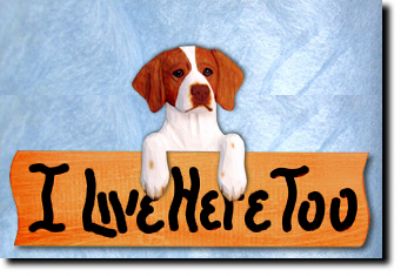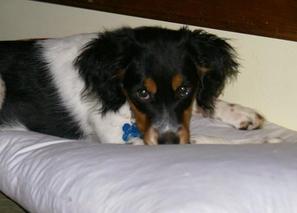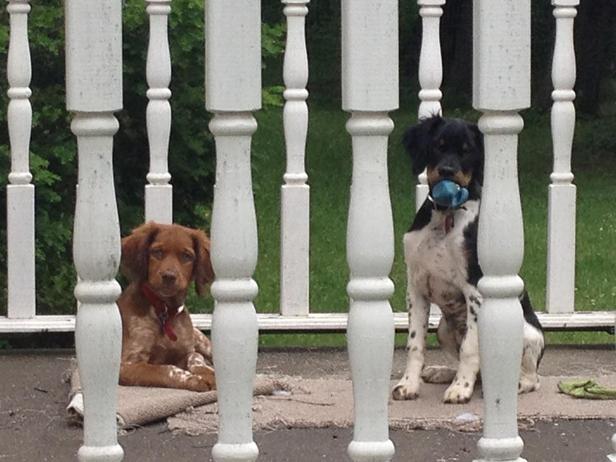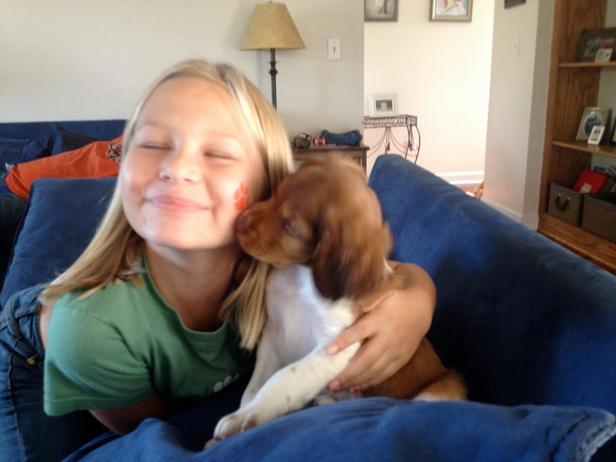Understanding the seven stages of puppy development
In order to understand why your puppy doesn't listen to you at times, you need to understand each stage of development a puppy goes through as it matures. Let's take a look at the different stages, but before we do, keep in mind that these stages are generalizations - each dog will progress at its own pace.
Stage 1: The Transitional Stage
2-3 Weeks
The Transitional stage generally lasts from age two to three weeks, and it's during this time that your puppy's eyes will open, and he'll slowly start to respond to light and movement and sounds around him. He'll become a little more mobile during this period, trying to get his feet underneath him and crawling around in the box (or wherever home is). He'll start to recognize mom and his littermates, and any objects you might place in the box.
Stage 2: The Almost Ready To Meet The World Stage
3-4 Weeks
The Almost ready to meet the world stage lasts from 3 to about 4 weeks, and your puppy undergoes rapid sensory development during this time. Fully alert to his environment, he'll begin to recognize you and other family members. It's best to avoid loud noises or sudden changes during this period - negative events can have a serious impact on his personality and development right now. Puppies learn how to be a dog during this time, so it's essential that they stay with mom and littermates.
Stage 3: The Overlap Stage
4-7 Weeks
From 3-4 weeks, your puppy begins the most critical social development period of his life - he learns social interaction with his littermates, learns how to play and learns bite inhibition. He'll also learn discipline at this point - Mom will begin weaning the pups around this time, and will start teaching them basic manners, including accepting her as the leader of the pack. You can begin to introduce food to the pups starting around the 4th week - transition gradually as Mom weans them.
Continue handling the pups daily, but don't separate them from either Mom or litter mates for more than about 10 minutes per day. Puppies that are removed from the nest too early frequently are nervous, more prone to barking and biting and have a more difficult time with socialization and training. Puppies need to be left with Mom and siblings until at least 7 weeks of age - and preferably a little longer - for optimum social development.
Experts say that the best time in a puppy's life to learn social skills is between 3 and 16 weeks of age - that's the window of opportunity you have to make sure your puppy grows up to be a well-adjusted dog. It's extremely important to leave your puppy with Mom and his littermates during as much of this period as possible. Don't discipline for play fighting, housebreaking mistakes or mouthing - that's all normal behavior for a puppy at this stage.
Stage 4: The "I'm Afraid of Everything" Stage
8 Weeks to 3 Months
The "I'm Afraid of Everything" Stage lasts from about 8 weeks to 3 months, and is characterized by rapid learning as well as a "fearful period" that usually pops up at around 8 to 10 weeks. Not all dogs experience this, but most do, and they'll appear terrified over things that they took in stride before. This is not a good time to engage in harsh discipline (not that you ever should anyway!), loud voices or traumatic events.
At this time your puppy's bladder and bowels are starting to come under much better control, and he's capable of sleeping through the night (At last, you can get some rest!). You can begin teaching simple commands like come, sit, stay, down, etc. Leash training can begin. It's important not to isolate your puppy from human contact at this time, as he'll continue to learn behaviors and manners that will affect him in later years.
Stage 5: The Juvenile Stage
3 Months to 4 Months
The Juvenile stage typically lasts from 3 to 4 months of age, and it's during this time your puppy is most like a toddler. He'll be a little more independent - he might start ignoring the commands he's only recently learned - just like a child does when they're trying to exert their new-found independence. As in "I don't have to listen to you!". Firm and gentle reinforcement of commands and training is what's required here.
He might start biting you - play biting or even a real attempt to challenge your authority. A sharp "No!" or "No bite!" command, followed by several minutes of ignoring him, should take care of this problem.
Continue to play with him and handle him on a daily basis, but don't play games like tug of war or wrestling with him. He may perceive tug of war as a game of nce - especially if he wins. And wrestling is another game that can rapidly get out of hand. As your puppy's strength grows, he's going to want to play-fight to see who's stronger - even if you win, the message your puppy receives is that it's ok to fight with you. And that's not ok!
Stage 6: The Brat Stage
4-6 Months
The Brat Stage starts at about 4 months and runs until about 6 months, and it's during this time your puppy will demonstrate even more independence and willfulness. You may see a decline in his urge to please you - expect to see more "testing the limits" type of behaviors. He'll be going through a teething cycle during this time, and will also be looking for things to chew on to relieve the pain and pressure. Frozen doggie bones can help sooth him during this period.
He may try to assert his new "dominance" over other family members, especially children. Continue his training in obedience and basic commands, but make sure to never let him off his leash during this time unless you're in a confined area. Many times pups at this age will ignore commands to return or come to their owners, which can be a dangerous, even fatal breakdown in your dog's response to you. If you turn him loose in a public place and he bolts, the chances of injury or even death can result - so don't take the chance.
He'll now begin to go through the hormonal changes brought about by his growing ual maturity, and you may see signs of rebelliousness (Think adolescent teen-age boy!). If you haven't already, you should have him neutered or spayed during this time.
Stage 7: The Young Stage
6-18 Months
The Young hood stage lasts from 6 months to about 18 months, and is usually a great time in your dog's life - he's young, he's exuberant, he's full of beans and yet he's learning all the things he needs to become a full-fledged dog.
Be realistic in your expectations of your dog at this time - just because he's approaching his full growth and may look like an , he's not as seasoned and experienced as you might expect. Gradually increase the scope of activities for your dog, as well as the training. You can start more advanced training during this period, such as herding or agility training, if that's something both of you are interested in. Otherwise, extend his activities to include more people and other animals - allow him to interact with non-threatening or non-aggressive dogs.
Congratulations! You've raised your puppy through the 7 stages of childhood, er, I mean puppyhood, and now you have a grown-up, dog! Almost feels like you've raised a kid, doesn't it?
The 7 Stages of Puppy Development
by Charlie Lafave
Chippewa Farms
French Brittany's
Keeping your dog's teeth clean can help keep your dog healthy .Use a soft toothbrush. Start by offering your dog a taste of the dog toothpaste. The next time, let him taste the toothpaste, then run your finger along the gums of the upper teeth. Repeat the process with the tooth brush. Get the bristles of the brush along the gum line of the upper back teeth and angle slightly up, so the bristles get under the gum line .Work from back to front,
making small circles along the gum lines. It should take you less than 30 seconds to brush your pet's teeth. Do not try to brush the entire mouth at first. If all that your pet lets you brush is the outside of the upper teeth, you are still addressing the most important area of periodontal disease - prevention
Healthy Dog Teeth
In temperament, the Brittany is friendly and eager to please. These friendly little dogs hunt more like a Setter due to their pointing ability, and are higher on their legs than other Spaniels. They also hunt closer than the American Brittany and the English pointers. The Brittany does not require a heavy hand in training. In fact, they may quit if the discipline is too stern. Much more is accomplished with a gentle hand. They seek human attention, which makes them easier to train than some other hunting breeds. They make close working hunting dogs, fine companions, and family pets.
Characteristics Of the French Brittany
CHARACTERISTICS OF MALE
Affectionate- Male dogs are typically more affectionate than bitches. They tend to crave attention from their owners more than bitches and as a result, display more affectionate behaviors.
Exuberant- A male dog is also more likely to be fun-loving and outgoing throughout his lifetime than a bitch. While a bitch tends to become more reserved as she ages, a male dog maintains a more puppy-like exuberance throughout his lifetime.
Food-Motivated- Males are often very motivated by food. This food motivation can make training extremely easy as treats can be used to lure and reward a dog to display desired behaviors.
Attentive While bitches tend to be more independent, males tend to be more focused on their human companions. They want to always be close to the human and are very eager to please.
Aggressive Behaviors - It is also important to note that intact males may display aggressive behaviors toward other males or exhibit marking behaviors. Additionally, intact males should be kept away from females in heat unless a breeding is planned.
CHARACTERISTICS OF FEMALE
In some ways, choosing between male and female dogs is a matter of personal preference. However, there are some characteristics which are common in bitches and other characteristics which are common in male dogs.
Independent - Bitches tend to want to be in control of the entire situation. They may come to their owner when they are seeking affection but will often move away when they have had enough.
Stubborn - In many packs, a bitch is typically the Alpha. Female dogs crave more control of situations and are quick to respond to perceived challenges with fierceness.
Territorial - Female dogs mark in the same way male dogs do. A spayed female may continue to mark for her entire lifetime regardless of when she is spayed while most males will cease marking behaviors shortly after they are neutered and the testosterone levels subside.
Reserved - Bitches are generally less affectionate and friendly than male dogs. This characteristic is noticeable in puppies and becomes more pronounced with age.
Changes in Mood or Behavior - It is also important to note that if you do not spay your bitch, she will come into heat at approximately one year of age and approximately every six months thereafter. During this time, there will be some bleeding as well as a change in mood or behavior.
Adding a New puppy to your home:
Introducing your pup to its new home
At the beginning, make sure to feed the new member of the household in a separate location.
At least separate food bowls as much as possible for the first few days. Aside from love, food is everything to your pets.
So don't encourage ill will between future buddies with a too-close-for-comfort feeding time routine.
Dog Grooming, Brush or comb your dog regularly. Check your dog's skin every so often for any kind of irritation, redness or unusual growths. Don't forget to check for external parasites like fleas and ticks.
There are 3 things that can have a major impact on your dog's health: his age, his weight,his teeth and his mobility.
What can you do to help keep your dog healthy?
1. Encourage play . Many aging dogs may prefer a nice nap to an active game of fetch or Frisbee, but it's important to play with them regularly. Play helps keep dogs in shape.
2. Monitor the chow. When it comes to eating, no dog is going to turn down a juicy, tasty meal. Overeating is the #1 cause of canine obesity, so it's up to us as good pet parents to monitor our dogs' diets and keep them at an ideal weight. That extra weight a dog carries is really hard on the dog's joints.
3. Feed a good quality dog food. Make sure your dog gets all the nutrients he needs. Some foods such as Pedigree have developed a Specialized Nutrition line that meets a dog's three critical needs: Healthy Longevity, Healthy Weight & Healthy Mobility. The Specialized Nutrition line has proven formulas rich in antioxidants, proteins, fiber and omega-3 fatty acids, which have been shown to improve health.
There are many things that can impact your dog's health, but if you monitor him and keep his diet healthy, it will give you greater peace of mind.
Try to keep your aging dog at an ideal weight. And if you have slippery flooring, place rugs down to give him secure footing.
CONTACT INFO: CHIPPEWAFARMS@GMAIL.COM
PH# 803-892-5210 OR 803-580-9245



